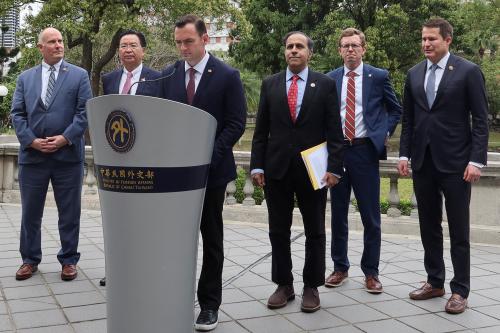“The two happiest days of a Prime Minister’s life are the day he enters office and the day he leaves office.” Such were the words of condolence that Canada’s longest serving Prime Minister, Mackenzie King, offered to R. B. Bennett on his Conservative Government’s loss to King’s Liberals in 1935.
Allowing that that sentiment may have accurately described King, it could scarcely describe John Diefenbaker’s time as Prime Minister between 1957 and 1963. His minority Government entered office in 1957 with hope, won the 1958 election with a level of unprecedented support, but lost power five years later when his Government collapsed in shambles. Diefenbaker’s time as Prime Minister demonstrated in spades that being a populist politician is no guarantee of being a good manager.
Had “Dief” (as he was known to one and all in Canada) been asked which his “happiest” days were in office he would, in typical Diefenbaker fashion, have offered a small catalogue. It would almost certainly have included several of the high points of his Government’s time in office.
He took great pride in two pieces of legislation approved by Parliament in 1960: extending the vote in federal elections to status Indians and adopting the Canadian Bill of Rights, the statutory precursor of the constitutionally entrenched Canadian Charter of Rights and Freedom of 1982.
Diefenbaker valued Canada’s connection with the Monarchy and the Commonwealth, and he treasured his world tour of late 1958 during the course of which he visited several Commonwealth countries in the southern hemisphere. The role that he played in having the Commonwealth approve a statement on racial equality was instrumental in forcing South Africa out of the Commonwealth and in heightening international opposition to apartheid in that country.
Diefenbaker also cherished his warm relationship with US President Eisenhower, a remarkable contrast to his subsequent association with Eisenhower’s successor, John F. Kennedy. Several jointly sponsored American-Canadian initiatives helped Ike and Dief extend the longstanding friendly relationship between the two countries. These included the 1958 agreement to integrate the US-Canada air command through the establishment of NORAD; the opening in 1959 of the St. Lawrence Seaway; and the signing in 1961 of the Columbia River Treaty just days before Eisenhower left the White House.
There would doubtless be other initiatives undertaken by Diefenbaker’s Government that he would point to (a number of which would prove to be less important in reality than in his sometimes fantasy-prone mind), but none would equal possibly the “happiest” day of all for him: the massive electoral victory of the Progressive Conservatives on 31 March 1958.
Looking back on the magnitude of that victory fifty years ago this week through the prism of a Canadian party system that is now fractionalized and regionalized, we can appreciate what an accomplishment the big Diefenbaker win of 1958 really was. (Ironically, that victory also serves as a warning about the dangers of lopsided electoral victories. Governments can read the results the wrong way, become complacent, overly cocky, and dismissive of signs of public discontent).
Diefenbaker had taken over a largely Ontario-based party in 1956 and transformed it into a truly national party over the course of the next two years. He likened it to leading his troops out of “the wilderness,” one of the many biblical images he took joy in embracing.
For their part, the Liberals did their best to make it easy for Diefenbaker in his early years as Tory leader. Their 22 consecutive years (1935-1957) in office had given them a sense of invincibility and had endowed them a hubris that to this day has known no equal in Canadian political history.
Liberal arrogance provided Dief with one effective kind of electoral ammunition. But in addition, for the 1958 election he fashioned a new partnership of political and regional interests that scarcely resembled the Tory party of the past or, for that matter, of the future. Diefenbaker’s thundering Old Testament oratory was matched by several key organizational coups. What Diefenbaker did in 1958 was to create a classic electoral coalition of otherwise separate political forces – something only Brian Mulroney has since replicated, in 1984.
Robert Stanfield and Dalton Camp, two master political strategists in Atlantic Canada, delivered the Maritimes to Diefenbaker’s Progressive Conservatives. The Premiers of the two largest provinces played a considerable role in the 1958 victory: Maurice Duplessis and his legendary Union Nationale organization brought Quebec onside just as Lesley Frost and his Blue Machine did in Ontario. Diefenbaker’s populism in the West made up for what his party lacked in organization presence there.
It all came together for one brief moment: 31 March 1958. The PCs won a clear majority of the votes (rare in Canada) and an unprecedented 208 of the 265 seats in the Commons. For Diefenbaker the colossal 1958 win must have been one of his “happiest” prime ministerial moments.
It would be a misrepresentation to say it was downhill all the way after that. But an early indication of what lay ahead for Canadians and for the Diefenbaker Government came in 1959 with the abrupt termination by the Government of the Avro Arrow project. The Arrow (to which many Canadians remain fondly attached to this day, if only in distant memory) was a Canadian designed and built state-of-the-art, delta-wing supersonic interceptor that was widely praised by NATO officials. Its cancellation, at a cost of $470 million (1959 Cdn$), dealt a crippling blow to Canada’s aerospace industry. Overnight 14,000 highly skilled workers employed in the design and production of military aircraft in Canada lost their jobs, and of those many of the most highly trained made their way to the US space program. It is not an overstatement to claim that the erosion of public confidence in the Diefenbaker Government began with that decision.
Ironically, the Arrow cancellation was almost certainly the right move. Cost overruns, failure to obtain contracts, and uncertainty about the utility of producing manned interceptors at the dawn of the era of Intercontinental Ballistic Missiles, were reason enough for the Diefenbaker Government to end the Arrow program. As politically unpopular as the move proved to be, it nonetheless showed a Government willing to risk public backlash on an issue of considerable substance. But in doing so, it paid a huge political price.
The controversies over North American air defense did not stop there, and in the end they contributed to the downfall of the Diefenbaker Government.
In signing on to NORAD, Canada had agreed to deploy two squadrons of Bomarc missiles on bases in northern Ontario and northern Quebec. When it later became known publicly that the missiles were to be fitted with nuclear warheads the issue of whether or not Canada should “enter the nuclear club,” as it were, proved to be highly controversial in the country. Nowhere were the divisions more pronounced than around the cabinet table of the Diefenbaker Government.
Once the Government, following prolonged and bitter debates, decided not to accept the warheads, the split within the party’s senior ranks became open and vicious. The Minister of Defense resigned from Cabinet in early February 1963, and soon after the Government was forced into an election when it was defeated in the House of Commons on a vote of confidence. Two more Cabinet ministers immediately quit, and the electoral hand-writing was on the wall. The Liberal party under Lester Pearson won the most seats (though not a clear majority) in the ensuing election and formed the new Government.
Diefenbaker saw his defeat as proof, at least in his mind, of American interference in Canadian politics. He was convinced that “the Kennedys” wanted Pearson as Prime Minister of Canada and had meddled in internal Canadian affairs to ensure that. The jury remains divided on whether such paranoia was justified on Diefenbaker’s part.
What is clear is that Diefenbaker and John F. Kennedy had a far cooler and testier relationship than the Prime Minister had had with Eisenhower. JFK was known to have been furious with Canada’s delayed response to America’s stand-by alert during the Cuban Missile Crisis of 1962, although in fairness Canada was not consulted beforehand about JFK’s move even though it was expected to play a role in the air defense of North America.
That issue was further complicated by the fact that four years had lapsed since the two countries signed on to the NORAD agreement and the Bomarcs were in their silos on Canadian soil but without nuclear warheads. When Pearson reluctantly promised in the heat of the 1963 election campaign to ensure that Canada would live up to its defense commitments with America and accept nuclear warheads, Diefenbaker saw this as further evidence of a Pearson-Kennedy plot. The new Liberal Government lived up to its promise and installed the warheads at the end of 1963.
Mackenzie King’s prime ministerial maxim can at best have been only half true in John Diefenbaker’s case. His Government’s stunning and lopsided victory of 31 March 1958 could certainly qualify as one of the happiest (perhaps THE happiest) moment of Diefenbaker’s years as Prime Minister. But that could scarcely be imagined to have been the case five years later when, as a bitter and suspicious leader of a party at odds with itself and with the country, he was forced out as Canada’s 13th Prime Minister.


Commentary
Op-edTaking Stock of Diefenbaker at 50
April 2, 2008